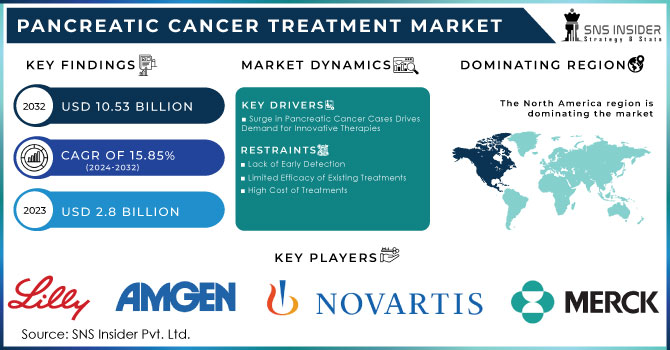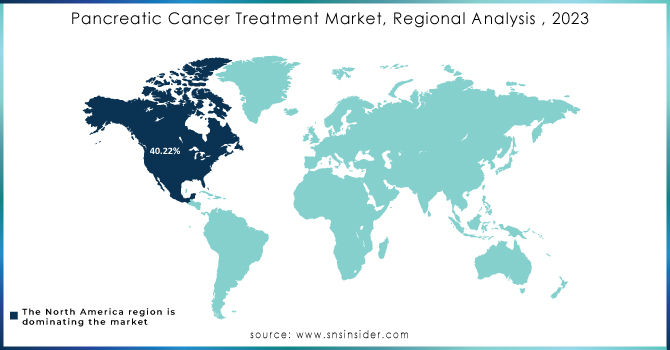Pancreatic Cancer Treatment Market Size and Trends:

Get More Information on Pancreatic Cancer Treatment Market - Request Sample Report
The Pancreatic Cancer Treatment Market size was valued at USD 2.8 billion in 2023 and is expected to reach USD 10.53 billion by 2032 and grow at a CAGR of 15.85%.
The demand for effective pancreatic cancer treatments is undeniably high. The growing number of diagnoses, with the aggressive nature of the disease, fuels the market. This demand is further amplified by rising awareness and a focus on personalized medicine, leading to potentially more targeted and effective therapies. Pancreatic cancer remains a formidable foe, with the American Cancer Society estimating over 66,000 new diagnoses and a staggering 51,750 deaths in the US alone for 2024. This translates to 3% of all cancers and a grim 7% of all cancer fatalities, highlighting the urgent need for improved treatment options.
The pancreatic cancer treatment market is driven by several factors, including the rising prevalence of obesity, alcohol consumption, and smoking. These lifestyle factors, combined with the growing geriatric population, are expected to fuel market growth. Additionally, personal or family history of pancreatitis and BRCA2 mutation predisposes individuals to pancreatic cancer, further driving demand for effective treatments. According to the CDC, approximately 12.5% of American adults were current smokers in 2023. This equates to roughly 30.8 million people. The CDC reported that 56.3% of American adults aged 18 or older consumed alcohol in the past month. This translates to approximately 140 million people.
On the supply side, pharmaceutical companies are actively involved in research and development. Verastem's promising combo therapy, currently in early trials, exemplifies this drive for innovation. Additionally, the success of NALIRIFOX paves the way for further exploration of targeted drug combinations. Moreover, 322 studies were under clinical trial according to clinicaltrail.com in their 3, and 4 phases.
Governments also play a crucial role with increased funding for research initiatives and streamlined regulatory processes can accelerate the development and approval of new treatments. Collaborations between public and private entities foster progress, with the shared goal of improving patient outcomes.
Traditionally, treatment options have been limited. However, recent advancements offer a glimmer of hope. The FDA's approval of NALIRIFOX, a new first-line treatment for metastatic pancreatic cancer, marks a significant stride. This drug combination, backed by positive clinical trial results showing improved overall survival compared to the standard regimen, provides much-needed relief for patients with previously limited options.
One promising approach involves the use of nanoparticles. These tiny particles can be designed to target cancer cells specifically, reducing damage to healthy tissues. Silver nanoparticles, in particular, have shown promise due to their ability to absorb light, especially in the near-infrared (NIR) region.
Recent studies have explored the use of IgG-functionalized silver nanoparticles for photothermal therapy. This approach has shown promising results in inducing cell death through apoptosis. Another area of focus is the exploration of DNA-based therapies. Researchers have discovered that pancreatic cancer can shut down key molecules in a crucial gene, allowing the disease to grow and spread rapidly. By targeting this genetic mutation, scientists are working to develop treatments that could potentially reverse the disease's progression.
The overall market for pancreatic cancer treatments is expected to experience significant growth due to the increasing prevalence of the disease and the ongoing search for effective therapies. The development of innovative approaches, such as nanoparticle-based and DNA-targeted therapies, offers hope for patients and presents opportunities for pharmaceutical companies and research institutions.
Market Dynamics
Drivers
-
Surge in Pancreatic Cancer Cases Drives Demand for Innovative Therapies
The aging population and lifestyle-related factors contribute to a surge in pancreatic cancer cases. The aggressive nature of the disease and its high mortality rate demand innovative therapies. Advancements in medical technology, such as targeted therapies and nanotechnology, offer promising potential. Rising awareness and government initiatives drive increased investment in research and treatment. Pharmaceutical companies and academic institutions are actively engaged in research and development to discover new treatments. Government initiatives, including funding and regulatory support, accelerate the development and approval of therapies. These factors collectively drive the market's growth and the pursuit of more effective and personalized pancreatic cancer treatments.
Restraints
-
Lack of Early Detection
Pancreatic cancer often remains asymptomatic in its early stages, making it difficult to detect. Symptoms like abdominal pain, weight loss, and jaundice often appear only after the cancer has progressed to an advanced stage. This late diagnosis significantly limits treatment options. While surgery may be an option in early-stage cases, advanced-stage pancreatic cancer is typically inoperable. Patients may still receive chemotherapy or radiation therapy, but the prognosis is significantly worse due to the advanced nature of the disease.
-
Limited Efficacy of Existing Treatments
-
High Cost of Treatments
-
Adverse Effects of Treatments
Pancreatic Cancer Treatment Market Segmentation Overview
By Affected region
Exocrine cancers, which account for the majority of pancreatic cancer cases, dominated the market with a 63.23% share in 2023. While endocrine cancers are less prevalent, they present a significant unmet need for effective treatments.
The exocrine segment is expected to experience robust growth throughout the forecast period, driven by increasing prevalence and the expanding reach of innovative techniques in developing regions. Although investment in research and development is substantial for both types of cancers, the exocrine segment is poised to benefit from the growing focus on early detection and targeted therapies.
By Type
The pancreatic cancer treatment market is segmented into chemotherapy, targeted therapy, and others, encompassing surgery, radiation techniques, and additional therapies. Targeted therapy, dominated the market in 2023 with a 56.04% share, and is poised to maintain its dominance throughout the forecast period.
The market's growth is driven by the introduction of novel biologic therapies and targeted drugs designed to mitigate the adverse effects of traditional chemotherapy. These advancements are expected to significantly increase the demand for targeted drugs during the forecast period.
Regional Analysis
North America dominated the pancreatic cancer treatment market with a 40.22% share in 2023, driven by its advanced healthcare infrastructure, widespread adoption of treatment procedures, and a significant target population. The region's high incidence of pancreatic cancer fuels the demand for effective treatment options.
However, the Asia-Pacific region is poised for rapid growth. The presence of well-established hospitals and critical care centers, coupled with a large population affected by pancreatic cancer, is expected to significantly boost the market in this region. As the number of cases continues to rise, there is a growing need for standardized diagnosis and treatment protocols in the Asia-Pacific region, aligning with Western practices.

Do You Need any Customization Research on Pancreatic Cancer Treatment Market - Enquire Now
Key Players
The key players are Eli Lilly and Company, Celgene Corporation, F. Hoffmann-La Roche AG, Amgen Inc., Novartis AG, PharmaCyte Biotech Inc., Clovis Oncology, Teva Pharmaceutical Industries Ltd., Merck & Co., Inc., Pfizer, Inc. and others.
Recent Developments
In August 2024, a new study explored the use of a repurposed chemotherapy drug in combination with nanotechnology to improve drug delivery and effectiveness against pancreatic cancer. This approach aims to make the treatment more targeted and reduce side effects, potentially opening up new possibilities for more effective therapies.
In early 2023, the FDA approved NALIRIFOX, a new combination therapy, as a first-line treatment for metastatic pancreatic cancer. This marked a significant advancement in treatment options.
In July 2023, a combination immunotherapy approach using the pancreatic cancer vaccine GVAX, along with immune checkpoint therapy and an antibody, showed a promising immune response in operable pancreatic cancers. This three-pronged treatment could pave the way for more effective immunotherapy protocols soon.
| Report Attributes | Details |
| Market Size in 2023 | US$ 2.8 billion |
| Market Size by 2032 | US$ 10.53 billion |
| CAGR | CAGR of 15.85% From 2024 to 2032 |
| Base Year | 2023 |
| Forecast Period | 2024-2032 |
| Historical Data | 2020-2022 |
| Report Scope & Coverage | Market Size, Segments Analysis, Competitive Landscape, Regional Analysis, DROC & SWOT Analysis, Forecast Outlook |
| Key Segments | • By Affected region (Exocrine, Endocrine) • By Type (Chemotherapy, Targeted Therapy, Others) |
| Regional Analysis/Coverage | North America (US, Canada, Mexico), Europe (Eastern Europe [Poland, Romania, Hungary, Turkey, Rest of Eastern Europe] Western Europe] Germany, France, UK, Italy, Spain, Netherlands, Switzerland, Austria, Rest of Western Europe]), Asia Pacific (China, India, Japan, South Korea, Vietnam, Singapore, Australia, Rest of Asia Pacific), Middle East & Africa (Middle East [UAE, Egypt, Saudi Arabia, Qatar, Rest of Middle East], Africa [Nigeria, South Africa, Rest of Africa], Latin America (Brazil, Argentina, Colombia, Rest of Latin America) |
| Company Profiles | Eli Lilly and Company, Celgene Corporation, F. Hoffmann-La Roche AG, Amgen Inc., Novartis AG, PharmaCyte Biotech Inc., Clovis Oncology, Teva Pharmaceutical Industries Ltd., Merck & Co., Inc., and Pfizer, Inc. and others. |
| Key Drivers | • Surge in Pancreatic Cancer Cases Drives Demand for Innovative Therapies |
| Market Opportunities |
• Lack of Early Detection • Limited Efficacy of Existing Treatments • High Cost of Treatments • Adverse Effects of Treatments |

